While in Columbus, Ohio I had the good fortune to be given a tour of school gardens courtesy of Susan Weber and Noreen Warnock of Local Matters. Local Matters is an organization seeking to expand fresh food availability and accessibility to residents of Central Ohio. They are involved in a number of initiatives from community and school food gardens to selling food via their Greener Grocer program, advocating on behalf of local farmers and much more.
In a nutshell, they’ve got a lot going on.

Brookside Elementary Butterfly Garden (Click to see big) Note that it is shaped like a butterfly.
The first leg of our tour began with Brookside Elementary School, a public school that is very involved in butterfly gardening on the property as a part of the Monarch Teacher Network (Canadian Version here). They already have a few gardens on the property specifically designed and planted to attract migrating monarchs and while we were there a group of parents and students were busily working on a new garden. What particularly hit me about this school was the leadership and dedication of principal Fritz Monroe. This man really understands the importance of nature and hands-on learning for children and was obviously adept at transferring his enthusiasm to parents and students. The large group that was there and hard at work early in the morning on a Saturday, and during the summer no less, was a testament to that. Parents were keen to take us aside to express how much they admired and supported the work he is doing for their school. It was really touching and heartwarming to see such a supportive community working together. The school’s next plans include creating a food garden and an edible orchard on the property both of which will be implemented alongside a food education program for kindergarten to grade 2 students.
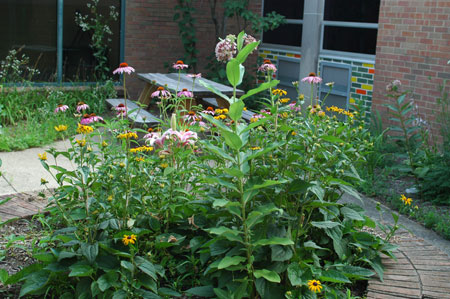
Fritz then took us indoors as a detour to the pond ecosystem they’ve established on the other side of the property. We never did make it there but were instead sidetracked by the amazing things they’ve got going on inside the school.
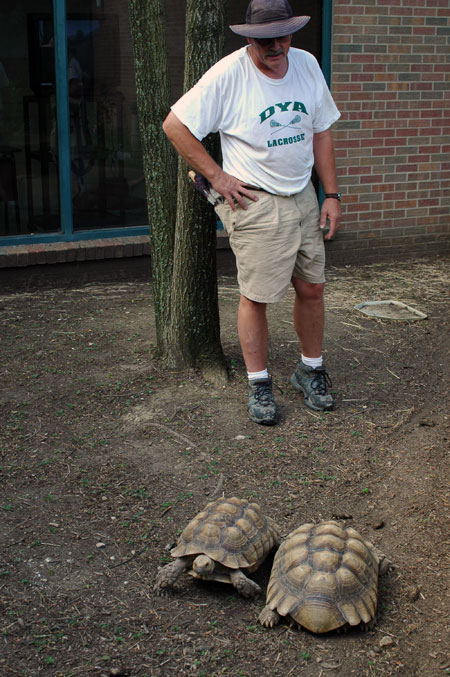
We passed a courtyard where more butterfly plants were growing and so were two large tortoises, Mr. Monroe’s personal pets brought to live in the fresh air during the summer months.
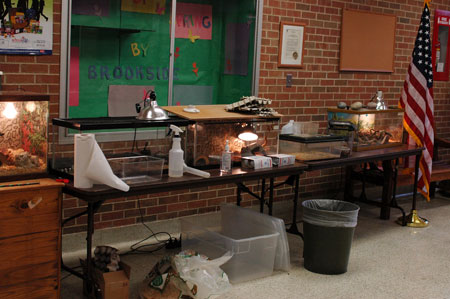
In the school’s front lobby we were astonished to find a large assortment of aquariums containing all sorts of lizards, snake and reptiles. And in the gym we were shown a monarch hatchery including several mesh cages of beautiful monarch chrysalids. Fritz also demonstrated a microscope projector, one of three in the school that are used to teach science as well as inspire discussions about more abstract concepts such as “delicate”, “fragile”, etc.
I can’t tell you how impressed I was with this school. I left wishing I could devolve and have a grade school redo there. This tour was particularly timely since I had only just finished writing about my grade two teacher Mrs. Hamson. Here I was impressed by a teacher who cared enough to teach students a lesson about earthworms, and this guy had created such a hospitable environment on the school property that they were hatching monarch chrysalids and attracting the two hawks we saw hanging out on a fence out back. I whispered to Susan, Noreen and Scott that my favourite thing about grade school was a large geode kept in the library. I would visit that geode regularly, marveling at it’s beauty. We all laughed because clearly this school made that geode look like little more then a shiny rock.

Next up was a detour to check out a playground revamp at the Early Childhood Learning Community. We only had a few brief minutes to take it in and snap some photos. I can’t say enough about this playground. I came away feeling very teary and hopeful for a future in which all kids have the chance to play in such a warm and inspiring environment. Most school gardens are set off to the side of the playground, created as a separate area that is only available to students when accompanied by adults or teachers. The playground itself continues to function as a sterile and all-too “safe” environment constructed of wood, concrete, plastic, mulch and that new bouncy turf. But this playground completely turns the entire concept around on its head, placing the playground within the garden. What’s more, this playground includes hand carved sculptures made by a local artist that the kids can climb on, a dry bed river that can be filled with flowing water and includes a small waterfall.
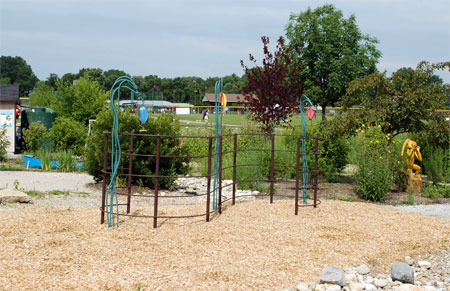
The children are actually encouraged to play in the water!
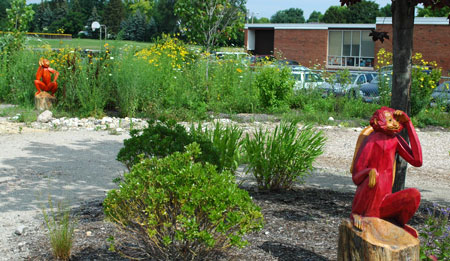
I looked around counting all the possible “danger” zones, amazed that the community had been willing to open up their hearts and minds to such a progressive concept. As I took it all in I imagined my child self interacting with such a space. When I was a kid I was so desperate for some nature to explore that I would spend some recesses searching for snails in a ditch along the outer regions of a vast, empty field. One of the so-called highlights of my schoolyard was the year I discovered four leaf clovers hidden amongst the turf grass. The occasional field trip hiking in a wooded area was a really big deal. My child mind got very excited by the amazing discoveries that could have been made playing in a small river bed or inspecting insects living on wildflowers and native plants in my very schoolyard.

The next elementary school we visited, Lincoln Park Elementary, was a little different. For one, they had need of a sign like this on the door.
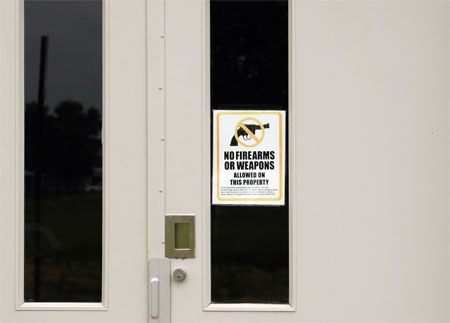
Local Matters worked alongside this community, along with project designer (and native plant landscaper) Amy Dutt, to create a raised spiral food garden on the property.
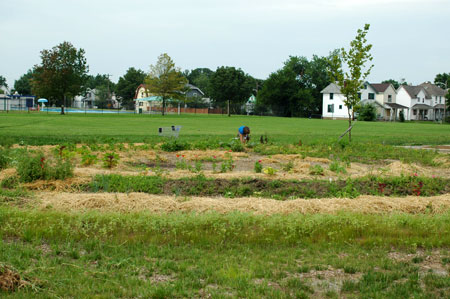
The spiral concept was created to allow the children to run inside the garden like a labyrinth. Unfortunately because this school was rated as having some of the worst grades in Ohio, the school system had gone the way of imposing more rigid structure and rules on the students and were not allowing the kids to interact with the garden as was initially intended. Here’s hoping that the community comes around to the value of the garden, eventually allowing the kids to play in and explore the plants.
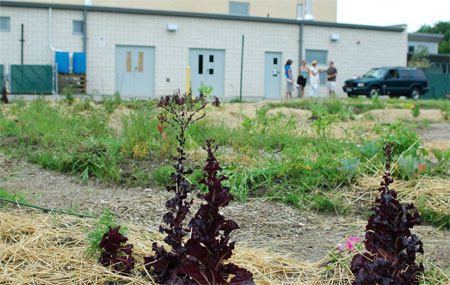
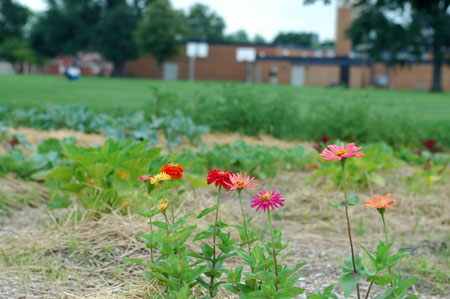
Pretty zinnias at Lincoln Park Elementary
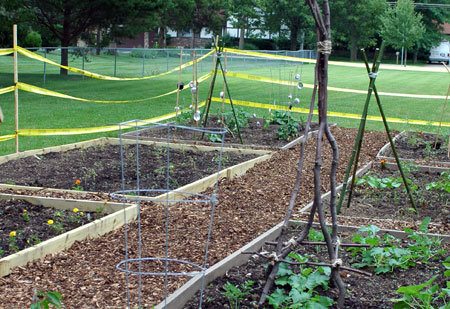
Our final garden stop of the tour was to the grand opening of a new kids’ community garden on the property of Whitehall Senior Center created with the help of Bill Dawson of the Growing to Green program (part of the Franklin Park Conservatory). I really wish we’d had more time to hang out at this garden. I really wanted to spend some time chatting with Bill, but alas we had to get back to the downtown in time to make our panel later that day. Bill’s name came up everywhere I went in Columbus — people just couldn’t say enough about him and the work he does in the community.
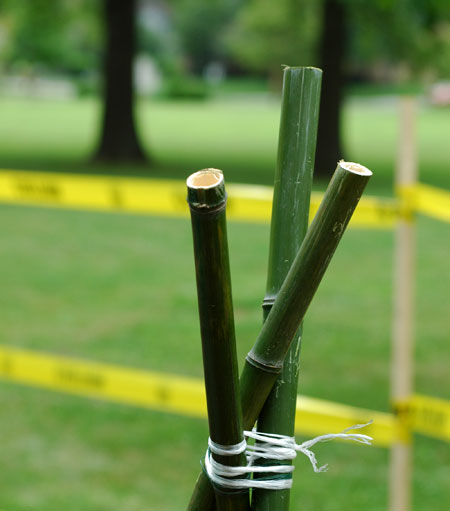
I couldn’t help but notice these freshly cut bamboo canes used to stake squash (or some kind of cucurbit). Bill informed me that he actually cut these canes from plants growing at the greenhouse. I know the sight of bamboo seems commonplace if not downright annoying to those living in the south, but as a northerner I can’t help but get excited about the fact that people can grow their own and then harvest it to fashion all sorts of objects for the garden.
Thanks so much to Scott Meyer of Organic Gardening Magazine for arranging the tour (and inviting me to be a part of it) and to Susan and Noreen for generously giving up their Saturday morning to show us the amazing work they are doing in Columbus. I am so grateful that I was able to spend the morning before the panel discussion with them, enjoying their company and conversation, and soaking in heaps of inspiration and all around good vibes from the work they are doing.
Lovely tour. Thanks for taking us along.
I feel the same way about willow as you do about bamboo. I wish we had willow here to make all sorts of things for the garden as they do in England.
That’s a neat tour you took! I also have fond memories of leaving the “play ground” at my elementary school and spending my lunch hours running through an adjacent vacant lot playing with wildflowers and searching for 4-leaf clovers.
Bamboo won’t grow in Toronto? Grows like a weed here. It’s totally taken over my aunt’s back yard!!!
thank you for letting us into you tour. hearing about the wonderful places and people and seeing the pictures is/was so inspiring! i got teary eyed at the dedication to and love for future generations who are too often unaware of the wonder around them, just waiting to be discovered. thank you for letting us experience this!
Wow…thanks for sharing your trip with us. Community projects like these are so inspiring!
I was lucky enough to have a small animal farm at my elementary school but I’m sure a garden would have made it that much more exciting. :o) I hope those kids in Columbus will one day realize what an amazing thing they were able to experience.
Don’t worry about the sign regarding the firearms, they are posted on most public places. It is a state law thing.
Gayla,
I too felt shorted on our visit in the garden. I was concentrating on the youth and the project at hand. You were with some amazing folks here in Columbus. I would have loved to take you around to the over 100 gardens that Growing to Green have been involved with! There is an inspiring story (or three)and folks at every urban garden here in Columbus! From the red monkey to the 100′ Native American mural to the blessed church garden that survived six feet of floodwaters to the Somali Horn of Africa garden…oh and the youth..they are as proud as our grandparents of what they are doing with food and flowers. It is people like you that continue to spread the WORD and thanks to those folks that have inspired me and fuel my passion to continue to help them truly make their communities productive, beautiful,green and safer places to live and play. Next time we will have to make more time to chat and explore CBus. Take care, Bill